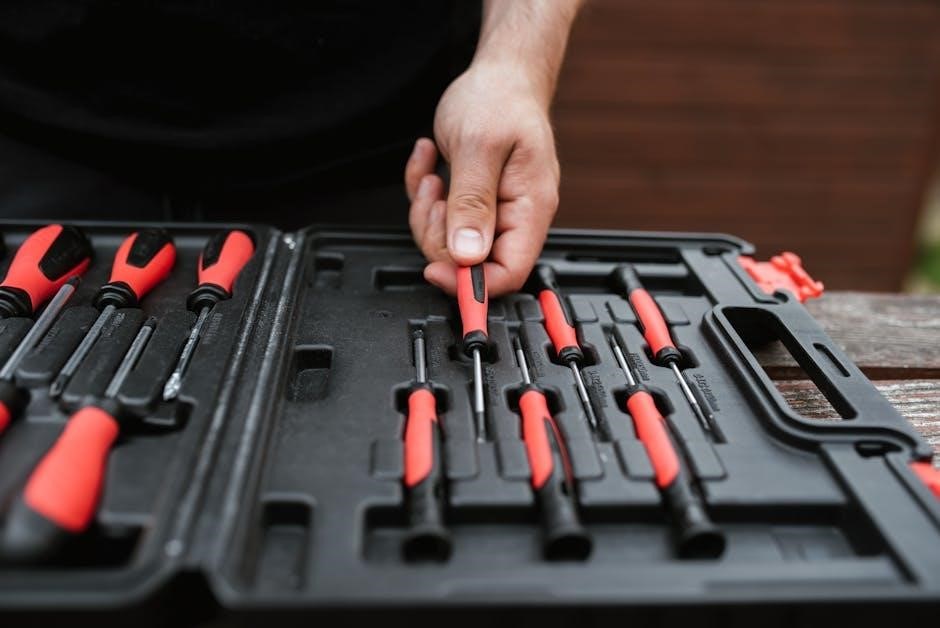Pro Tools is a digital audio workstation used for music and post-production, offering advanced features and tools for audio editing and mixing, with a user-friendly interface and customizable workflow options available․
Launching Pro Tools
To launch Pro Tools, ensure your audio interface is connected and powered on, then click the application icon on your computer․
The activation and authorization process must be completed as outlined in the Pro Tools Installation guide․
On Mac, click the application icon in the Dock, while on Windows, use the Start menu to locate and launch Pro Tools․
It is essential to follow the correct launch procedure to ensure a successful startup and access to Pro Tools’ features and functions․
Pro Tools will then guide you through the initialization process, allowing you to configure your system and audio settings․
By following these steps, you can quickly and easily launch Pro Tools and begin working on your audio projects․
Pro Tools provides a comprehensive set of tools for audio editing and mixing, and launching the software is the first step in accessing these features․
The launch process is straightforward, and Pro Tools is designed to be user-friendly, making it easy to get started with your audio work․
Authorization Process
The authorization process for Pro Tools is a crucial step in launching the software, as it verifies the user’s license and ensures that the software is being used in compliance with the terms of the agreement․
The process involves entering a unique authorization code, which is typically provided by Avid upon purchase or registration of the software․
This code is used to unlock the full features and functionality of Pro Tools, allowing users to access the software’s advanced tools and capabilities․
The authorization process is typically completed during the initial installation of Pro Tools, but it may also be required if the software is reinstalled or transferred to a new computer․
It is essential to follow the correct authorization procedure to ensure that Pro Tools is properly licensed and functioning correctly․
The authorization process is designed to be secure and prevent unauthorized use of the software, protecting the intellectual property and rights of Avid and its users․
By completing the authorization process, users can ensure that they have a legitimate and fully functional version of Pro Tools․

Getting Started with Pro Tools
Pro Tools offers a comprehensive guide and tutorial to help users get started with the software quickly and easily with interactive lessons․
Exploring the Demo Session
The demo session is a pre-installed project that allows users to explore the features and capabilities of Pro Tools in a real-world setting․ This session typically includes a variety of audio tracks, midi tracks, and effects, showcasing the software’s functionality․ By exploring the demo session, users can gain hands-on experience with Pro Tools and familiarize themselves with the interface and workflow․ The demo session is usually a medium-sized song project, complete with audio connections and a range of editing and mixing tools․ Users can navigate through the session, experimenting with different features and techniques to get a feel for how Pro Tools works․ This hands-on approach helps users to quickly understand the basics of Pro Tools and begin working on their own projects with confidence․ The demo session is an essential part of the Pro Tools learning process, providing a comprehensive introduction to the software’s capabilities․
Creating Your First Session
To create a new session in Pro Tools, users can start by selecting the desired session settings, such as sample rate, bit depth, and file type․ The software will then prompt the user to choose a location for the session file and select a template or start from scratch․ Once the session is created, users can begin adding tracks, importing audio files, and setting up their workflow․ The Pro Tools interface is designed to be intuitive, with clear and concise menus and toolbars that make it easy to navigate and find the features and functions needed to create a high-quality session․ By following the prompts and using the various tools and features, users can quickly and easily create their first session and start working on their audio project․ This process helps users to become familiar with the Pro Tools interface and workflow, setting them up for success in their future projects․

Pro Tools Specifications
Pro Tools requires a computer with specific hardware and software configurations to operate efficiently and effectively․
Avid Pro Tools 11․0 Specifications
Avid Pro Tools 11․0 is a professional audio editing software that requires a specific set of system specifications to operate efficiently․ The software is compatible with both Windows and Mac operating systems․
The minimum system requirements for Avid Pro Tools 11․0 include a multi-core processor, at least 4GB of RAM, and a compatible audio interface․
Additionally, the software requires a minimum of 15GB of free disk space and a compatible graphics card․
It is also recommended to have a high-speed internet connection for software updates and activation․
The specifications may vary depending on the specific needs of the user, such as the number of tracks and plugins used․
It is essential to check the system specifications before installing Avid Pro Tools 11․0 to ensure smooth operation and optimal performance․
The software is widely used in the music and post-production industries for its advanced features and tools․
Avid Pro Tools 11․0 is a powerful software that can handle complex audio editing tasks with ease․
The system specifications are available on the Avid website for users to check before purchasing the software․
System Requirements
To run Pro Tools efficiently, your computer must meet certain system requirements․
The operating system should be either Windows 10 or macOS High Sierra or later․
A multi-core processor is recommended, with a minimum of 2 GHz processing speed․
The minimum RAM requirement is 8 GB, but 16 GB or more is recommended for optimal performance․
A compatible audio interface is also necessary, such as those from Avid or other supported manufacturers․
Additionally, a minimum of 15 GB of free disk space is required for installation․
A compatible graphics card and a high-speed internet connection are also recommended․
It is essential to check the system requirements before installing Pro Tools to ensure smooth operation and optimal performance․
The system requirements may vary depending on the specific needs of the user, such as the number of tracks and plugins used․
Checking the system requirements beforehand can help prevent any potential issues during installation or use․
Pro Tools is a powerful software that requires a capable computer system to run efficiently․

Controlling Pro Tools

Pro Tools control options include EuControl and MIDI devices for customizable workflow and enhanced productivity features and tools․
The Control app is a powerful tool for controlling Pro Tools and other EUCON-aware media applications, allowing users to customize their workflow and enhance productivity․ With the Control app, users can control their audio sessions from a qualified Apple iPad, providing a flexible and portable solution for music and post-production professionals․ The app offers a range of features and tools, including customizable layouts and intuitive navigation, making it easy to use and integrate into existing workflows․ By using the Control app, users can streamline their workflow, improve efficiency, and focus on the creative aspects of their work․ The Control app is compatible with Avid media controllers, such as Pro Tools Dock, Pro Tools S3, and Artist Series devices, providing a comprehensive and integrated control solution for Pro Tools users․ Overall, the Control app is a valuable tool for anyone looking to get the most out of their Pro Tools system․
Using the Control App
To use the Control app, users must first download and install the app on their Apple iPad, then connect the device to their Pro Tools system via a network connection․ The app provides a range of features and tools, including transport controls, track navigation, and plug-in editing․ Users can customize the app’s layout to suit their needs, creating a personalized workflow that streamlines their production process․ The Control app also provides real-time feedback and monitoring, allowing users to make adjustments and tweaks on the fly․ With the Control app, users can work more efficiently and effectively, focusing on the creative aspects of their work rather than navigating complex menus and interfaces․ By integrating the Control app into their workflow, Pro Tools users can take their production to the next level, achieving professional-sounding results with ease and precision, and enhancing their overall user experience․